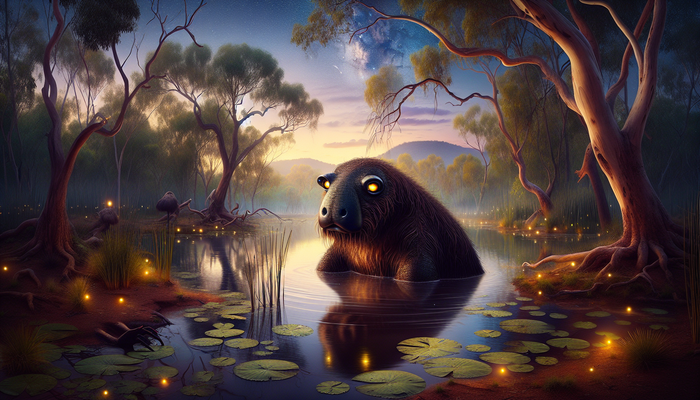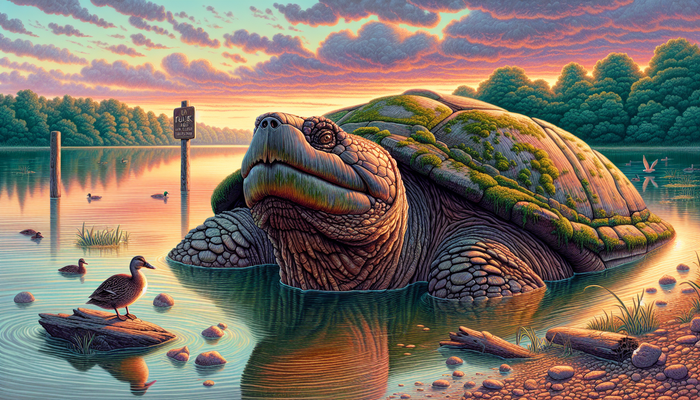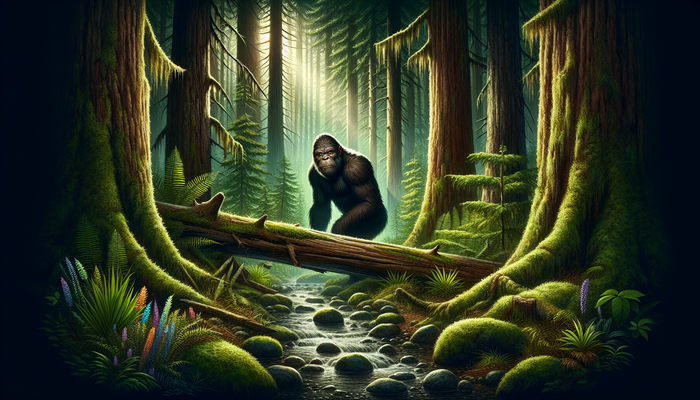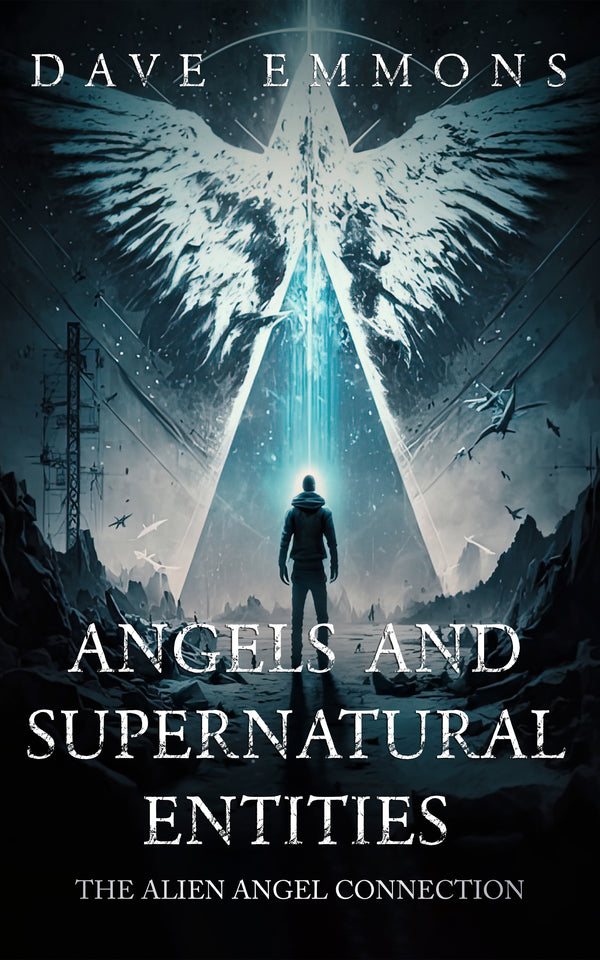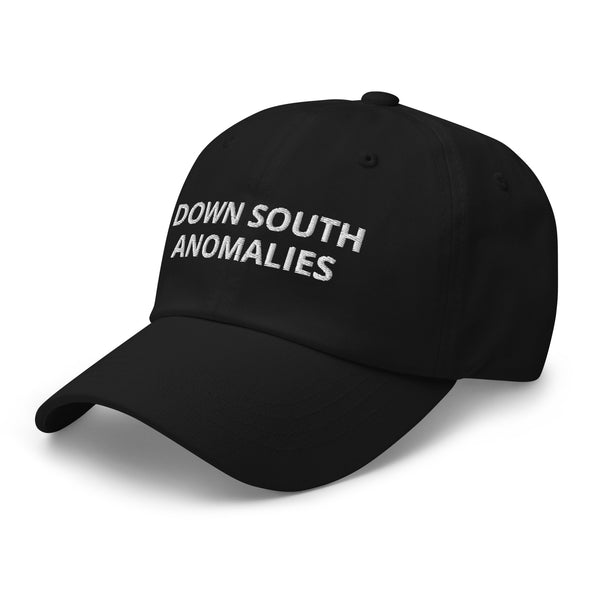Discovering the Mysteries of Shunka Warak’in: The Beast of Montana

By Anthony Romano, Cryptozoologist
Origins and Cultural Significance
The story of the Shunka Warak'in is as old as the wind that sweeps across the Great Plains, a tale passed down through generations of Native American tribes. The Ioway, Crow, and Blackfeet people, among others, have long spoken of this creature in hushed tones around flickering campfires. These oral traditions have served as the keepers of the Shunka Warak'in's legend, preserving its memory long before it caught the attention of the wider world.
In the rich tapestry of Native American folklore, the Shunka Warak'in occupies a unique place. It's not just another predator to be feared; it's a symbol of the wild's untamed spirit, a reminder of nature's power and mystery. The creature's reputation for stealing dogs from camps speaks to a deeper truth about the precarious balance between human settlements and the wilderness that surrounds them.
Imagine, if you will, a moonless night on the plains. The wind whispers through the grass, and the only light comes from the stars above and the dim glow of a dying campfire. It's in this setting that the Shunka Warak'in comes to life in the stories of the elders. They speak of its glowing eyes, visible in the darkness before any other part of its body can be seen. They tell of its eerie, almost human-like cry that echoes across the land, a sound that makes even the bravest warrior's blood run cold.
But the Shunka Warak'in is more than just a boogeyman used to frighten children into obedience. In many Native American cultures, it serves as a powerful metaphor for the dangers of disrespecting nature. The creature is often portrayed as a guardian of the wild, a force that punishes those who take more than they need or fail to honor the spirits of the land.
One particularly vivid tale from the Crow tribe speaks of a hunter who, driven by greed, killed more animals than he could possibly use. As night fell, he heard the unmistakable cry of the Shunka Warak'in. The beast pursued him relentlessly, not to kill him, but to teach him a lesson about the consequences of his actions. By dawn, the hunter had lost everything he had taken, and he returned to his people a changed man, with a newfound respect for the balance of nature.
This aspect of the Shunka Warak'in's mythology highlights a fundamental principle in many Native American belief systems: the interconnectedness of all living things. The creature serves as a reminder that humans are not separate from nature, but an integral part of it. Its presence in the folklore underscores the importance of living in harmony with the environment and respecting the delicate equilibrium of the natural world.
The Shunka Warak'in's role in Native American culture extends beyond cautionary tales. Some tribes believe that encounters with the creature are omens, foretelling significant events or changes. A sighting might herald the coming of a harsh winter, a bountiful harvest, or even the arrival of outsiders who would change their way of life forever.
In some traditions, the Shunka Warak'in is not just a physical being, but a shape-shifter, capable of taking on different forms to suit its needs. This belief adds another layer of complexity to the creature's mythology, suggesting that it possesses not just physical power, but spiritual significance as well.
The cultural impact of the Shunka Warak'in extends to rituals and ceremonies as well. Some tribes incorporated elements of the creature's legend into coming-of-age ceremonies, where young men would venture into the wilderness alone, facing their fears and proving their courage. The thought of encountering the Shunka Warak'in during these trials served as the ultimate test of bravery and resourcefulness.
As European settlers began to push westward, they too encountered the legend of the Shunka Warak'in. While many dismissed it as mere superstition, others found themselves captivated by the tales. The creature's legend began to evolve, incorporating elements of Old World folklore and the settlers' own experiences in the harsh frontier environment.
This blending of cultures created a new mythology around the Shunka Warak'in, one that reflected the changing face of the American West. The creature became a symbol of the untamed wilderness that the settlers sought to conquer, a reminder of the challenges and dangers that awaited them in this new land.
Today, the cultural significance of the Shunka Warak'in continues to resonate. It serves as a link to the past, a connection to the rich cultural heritage of the Native American tribes who first gave voice to its legend. For many, the creature represents the enduring mystery of the natural world, a reminder that despite our technological advances, there are still aspects of our planet that remain beyond our understanding.
The Hutchins Encounter: A Turning Point
The year was 1886, and the Madison River Valley of Montana was a place where the old ways of the frontier were slowly giving way to the encroachment of civilization. It was in this transitional landscape that Israel Ammon Hutchins, a Mormon settler with a sturdy frame and an even sturdier resolve, found himself face to face with a creature that would forever change the course of cryptozoological history.
Hutchins's ranch was a modest affair, carved out of the wilderness through sheer determination and backbreaking labor. Like many settlers of his time, he lived with one eye on his livestock and the other on the wild lands that surrounded his homestead. The threat of predators was a constant concern, but nothing could have prepared him for what he was about to encounter.
It began with whispers and worried glances among the local ranchers. Something was out there, something that didn't quite fit the usual pattern of wolf or mountain lion attacks. Livestock was being taken in a way that seemed almost... deliberate. Cows were found with peculiar wounds, and dogs went missing in the night, their chains snapped as if they were made of paper.
Hutchins, a pragmatic man not given to flights of fancy, initially dismissed these stories as the product of overactive imaginations. But as the attacks continued and drew closer to his own property, he found himself staying up late into the night, rifle at the ready, straining his ears for any unusual sounds.
It was on a crisp autumn morning that Hutchins's vigilance paid off. The sun had barely begun to peek over the horizon when he was jolted awake by the frantic barking of his dogs. Grabbing his rifle, he rushed outside, his breath forming small clouds in the chilly air.
What he saw next would be etched into his memory for the rest of his life. There, in the pale light of dawn, was a creature unlike anything he had ever seen before. It stood taller than any wolf, with high shoulders that gave it an almost bear-like appearance. But it was the creature's back that truly set it apart – it sloped downward in a way that reminded Hutchins of the hyenas he had seen in picture books.
The beast was in the midst of chasing Hutchins's geese, its dark fur making it look like a living shadow as it moved with surprising agility. Without hesitation, Hutchins raised his rifle and fired. The shot rang out across the valley, but to his astonishment, the creature barely flinched. It turned its gaze towards him, eyes gleaming with an almost human intelligence, before loping off into the underbrush.
Hutchins's encounter might have remained just another frontier tale, a story to be shared over whiskey in dimly lit saloons, if not for what happened next. A few days later, the creature returned. This time, Hutchins was ready. His aim was true, and the beast fell, its unearthly cry echoing across the land as it breathed its last.
Word of Hutchins's triumph spread quickly through the valley. Neighbors flocked to his ranch to see the carcass of the creature that had been terrorizing their livestock. What they saw both fascinated and disturbed them. The animal was like nothing they had ever encountered – part wolf, part hyena, and entirely other.
It was at this point that Joseph Sherwood entered the picture. A local businessman with a keen interest in the unusual, Sherwood saw an opportunity in Hutchins's strange kill. He offered to trade Hutchins a cow for the carcass, a deal that the practical rancher readily accepted.
Sherwood, who dabbled in taxidermy, set about preserving the creature. His work complete, he proudly displayed the mounted specimen in his combination grocery store and museum in Henry's Lake, Idaho. It was Sherwood who gave the creature the name that would follow it into legend: the "Ringdocus."
The Ringdocus quickly became a local sensation. People came from miles around to gaze upon the strange beast, marveling at its unique features and speculating about its origins. Some saw it as proof of the old Native American legends, while others theorized about undiscovered species lurking in the wilderness.
Hutchins's encounter and the subsequent preservation of the Ringdocus marked a turning point in the legend of the Shunka Warak'in. No longer was it merely a creature of campfire stories and native lore. Now there was tangible evidence, a physical specimen that could be seen and touched.
This shift from legend to potential reality opened up new avenues of inquiry. Scientists and naturalists began to take an interest in the creature, even as skeptics dismissed it as a hoax or a case of mistaken identity. The Ringdocus became a lightning rod for debate, a physical manifestation of the tension between the known and the unknown.
For Hutchins, the encounter left an indelible mark. He would recount the story countless times over the years, each retelling adding to the mystique of the creature. His grandson, Ross Hutchins, would later write about the incident in his book "Trails to Nature's Mysteries: The Life of a Working Naturalist," ensuring that the tale would be preserved for future generations.
The Hutchins encounter serves as a bridge between the oral traditions of the Native Americans and the more documented approach of modern cryptozoology. It represents a moment when legend and reality collided, leaving behind a mystery that continues to captivate and perplex to this day.
As we delve deeper into the story of the Shunka Warak'in, the Hutchins encounter stands as a testament to the enduring power of the unknown. It reminds us that even in a world that seems fully mapped and explored, there may still be wonders waiting to be discovered, creatures that defy our understanding and challenge our perceptions of the natural world.
The Ringdocus: A Cryptid in Taxidermy
The story of the Shunka Warak'in took a fascinating turn with the creation of the Ringdocus, the taxidermied specimen that would become the centerpiece of the creature's legend. This physical artifact, born from Israel Ammon Hutchins's fateful encounter, would go on to captivate the imagination of locals and researchers alike for decades to come.
Joseph Sherwood, the man responsible for preserving the creature, was more than just a simple shopkeeper. He was a collector of curiosities, a man with an eye for the unusual and the unexplained. His combination grocery store and museum in Henry's Lake, Idaho, was a testament to his eclectic interests. Amid canned goods and everyday sundries, visitors could find an array of oddities from the natural world and beyond.
The Ringdocus quickly became the crown jewel of Sherwood's collection. Mounted with care and displayed prominently, it drew curious onlookers from far and wide. People would come to buy their weekly provisions and end up spending hours examining the strange beast, its glass eyes seeming to stare back at them with an otherworldly intelligence.
Sherwood's decision to name the creature "Ringdocus" adds another layer of intrigue to the story. The origin of this peculiar name remains a mystery. Some speculate that it was a playful invention, a nonsense word designed to add to the creature's mystique. Others wonder if it might have some hidden meaning, perhaps derived from a Native American language or a corruption of a scientific term.
For decades, the Ringdocus stood as a silent sentinel in Sherwood's store, a physical link to the legends of the Shunka Warak'in. Generations of children grew up hearing stories of the beast, their wide eyes taking in every detail of its unusual form. It became a rite of passage for local youths to visit the store and see the creature for themselves, each visit adding to the growing mythology surrounding it.
But as with many such artifacts, the story of the Ringdocus took an unexpected turn. Sometime in the 1980s, the mounted specimen vanished. The circumstances of its disappearance remain shrouded in mystery. Some say it was sold to a private collector, while others speculate that it was removed to protect it from deterioration. Whatever the reason, the loss of the Ringdocus left a void in the community and in the world of cryptozoology.
For years, the only tangible evidence of the Ringdocus's existence was a black and white photograph published in Ross Hutchins's 1977 book, "Trails to Nature's Mysteries: The Life of a Working Naturalist." This grainy image became the subject of intense scrutiny among researchers and enthusiasts. Every detail was analyzed, from the creature's unusual proportions to the texture of its fur.
The photograph, while invaluable, left many questions unanswered. The limitations of black and white photography meant that crucial details about the creature's coloration were lost. The static nature of the image also made it difficult to fully appreciate the three-dimensional aspects of the specimen, leading to endless debates about its true form and nature.
It seemed that the Ringdocus, like the living Shunka Warak'in itself, had become a creature of legend, existing only in memories and that single, tantalizing photograph. But the story was far from over.
In a twist worthy of the best mystery novels, the Ringdocus resurfaced in 2007. Jack Kirby, another grandson of Israel Hutchins, had never forgotten the family stories about the strange creature his grandfather had shot. Driven by curiosity and a sense of family legacy, Kirby embarked on a quest to track down the long-lost specimen.
His search led him to the Idaho Museum of Natural History in Pocatello. There, tucked away in storage along with other taxidermied animals from Sherwood's collection, was the Ringdocus. After decades in the dark, the creature once again saw the light of day.
Kirby's rediscovery of the Ringdocus reignited interest in the Shunka Warak'in legend. He arranged for the specimen to be loaned to the Madison Valley History Museum in Ennis, Montana, bringing it full circle back to the region where its story began.
The return of the Ringdocus to public display was met with a mix of excitement and skepticism. For many, it was a chance to finally see the creature that had been the subject of so much speculation. Others saw it as an opportunity to apply modern scientific techniques to unravel the mystery of its identity.
Upon close examination, the Ringdocus revealed itself to be a creature of contradictions. Its overall form was indeed wolf-like, but with several notable departures from typical canine anatomy. The high shoulders and sloping back that had been described in so many accounts were clearly visible. Its fur, while faded with age, still hinted at the dark coloration that had made it so striking in life.
One of the most intriguing features of the Ringdocus is the faint impression of stripes on its flanks. This characteristic, not typically associated with wolves or dogs, has led some researchers to speculate about possible connections to other species or even to prehistoric creatures long thought extinct.
The reappearance of the Ringdocus has sparked renewed debate about its true nature. Some experts argue that it is simply an unusual specimen of a known species, perhaps a wolf with genetic anomalies or a hybrid of some kind. Others maintain that it represents an undiscovered species, a creature that has managed to evade scientific classification.
Despite the availability of the physical specimen, one crucial piece of evidence remains elusive: DNA analysis. The age of the Ringdocus and the taxidermy methods used in its preservation present significant challenges for genetic testing. Additionally, there are concerns about damaging the historic specimen in the process of obtaining samples.
The lack of definitive scientific evidence has, in some ways, only added to the Ringdocus's mystique. It remains a tangible link to the legend of the Shunka Warak'in, a physical manifestation of the stories that have been passed down through generations. Its presence in the museum serves as a reminder of the enduring power of mystery and the human desire to believe in the extraordinary.
Visitors to the Madison Valley History Museum often find themselves standing in quiet contemplation before the Ringdocus display. Children press their noses to the glass, their imaginations running wild with thoughts of what this creature might have been like in life. Adults study it with a mix of wonder and skepticism, weighing the evidence before them against their own beliefs about what is possible in the natural world.
The Ringdocus, in its silent, preserved state, continues to spark conversations and inspire new generations of researchers and enthusiasts. It stands as a testament to the enduring fascination with cryptids and the unknown, a physical anchor point for a legend that refuses to fade into obscurity.
As we continue to explore the mystery of the Shunka Warak'in, the Ringdocus remains at the heart of the story. It is both evidence and enigma, a relic of the past that continues to shape our understanding of what might still be out there, waiting to be discovered in the wild places of the world.
Modern Sightings and Encounters
While the Ringdocus stands as a tangible link to the past, the legend of the Shunka Warak'in is far from a mere historical curiosity. Reports of encounters with creatures matching its description continue to emerge from the wilds of Montana and beyond, keeping the mystery alive and evolving in the modern era.
One of the most notable recent incidents occurred between December 2005 and November 2006 in McCone County, Montana. During this period, a series of livestock attacks left ranchers and wildlife officials baffled. The creature responsible for these depredations quickly earned the moniker "The Creature of McCone County," and its exploits became the talk of the region.
The attacks were characterized by their unusual nature. Sheep were found dead or grievously wounded, with injuries that didn't match the typical patterns of known predators like wolves or mountain lions. Over the course of the year, the death toll mounted, eventually reaching a staggering 120 animals.
Local rancher Marvin Hott was one of those affected by the mysterious predator. In an interview with the local press, he described the scene he encountered one morning: "It was like nothing I'd ever seen before. The sheep weren't just killed, they were... mangled. And the tracks left behind, they were big, bigger than any wolf I've ever come across."
As news of the attacks spread, speculation ran rampant. Some saw it as the work of a particularly aggressive wolf pack, while others whispered about the return of the Shunka Warak'in. The incidents drew the attention of cryptozoologists and wildlife biologists alike, all eager to uncover the truth behind the killings.
The mystery came to a head on November 2, 2006, when Montana Wildlife Services agents finally managed to shoot and kill a creature they believed was responsible for the attacks. The animal they brought down, however, only deepened the mystery.
At first glance, the creature appeared to be a wolf, but there were several characteristics that set it apart. Its fur had an unusual reddish-yellow tint, quite different from the typical coloration of wolves in the region. Its physical proportions were also off – the legs seemed too short, the ears too large, and the claws unusually long for a wolf.
Wildlife officials were initially stumped. Carolyn Sime, who was then the wolf program coordinator for Montana Fish, Wildlife and Parks, stated in a press release: "We're not sure what we're dealing with here. It has some characteristics of a wolf, but there are enough anomalies to make us question its identity."
The carcass was sent to the National Fish and Wildlife Forensics Laboratory in Ashland, Oregon, for genetic testing. The results, when they finally came back, were anticlimactic for those hoping for evidence of a cryptid. The creature was identified as a four-year-old male gray wolf, albeit one with some unusual physical characteristics.
Despite the official explanation, many remained unconvinced. The incident had reignited interest in the Shunka Warak'in legend, and reports of similar creatures began to surface with increasing frequency.
In 2015, a rancher near Denton, Montana, reported seeing a large, dark creature with a sloping back stalking his property. He described it as moving with a gait unlike any wolf or dog he had ever seen. Though he was unable to capture photographic evidence, his description bore a striking resemblance to the traditional accounts of the Shunka Warak'in.
Another intriguing report came from the Bitterroot Valley in 2018. A group of hikers claimed to have encountered a large, wolf-like animal with unusually high shoulders and a coat that seemed to shimmer with a bluish-black hue in the sunlight. One of the hikers, Sarah Jennings, recounted the experience: "It was like time stood still. This... thing was just standing there, staring at us. It wasn't aggressive, but there was an intelligence in its eyes that was unsettling. When it turned to leave, that's when we saw its back – it sloped down in a way that just looked wrong for a wolf."
These modern sightings share many commonalities with historical accounts of the Shunka Warak'in. The descriptions of high shoulders, sloping backs, and dark fur persist, as does the sense of otherworldliness that seems to accompany encounters with these creatures.
What sets many of these contemporary reports apart is the emotional and psychological impact they have on witnesses. Many describe a feeling of profound unease or even a sense of being in the presence of something ancient and powerful. This aspect of the encounters has led some researchers to speculate about possible connections between the Shunka Warak'in and other cryptids or paranormal phenomena.
The advent of technology has also changed the landscape of cryptid sightings. Trail cameras, now commonly used by hunters and wildlife enthusiasts, have captured images of unusual animals that defy easy classification. While none of these photos or videos have provided definitive proof of the Shunka Warak'in's existence, they have added fuel to the ongoing debate.
Social media and online forums have become hotbeds of discussion and speculation about the Shunka Warak'in. Eyewitness accounts spread rapidly, often accompanied by blurry photos or shaky video footage. While this increased visibility has brought the legend to a wider audience, it has also made it more challenging to separate genuine sightings from hoaxes or misidentifications.
The cryptozoological community has responded to these modern sightings with renewed vigor. Expeditions have been mounted to areas where sightings are frequent, armed with advanced equipment like thermal imaging cameras and audio recording devices designed to capture any unusual vocalizations.
One such expedition, led by cryptozoologist Lyle Blackburn in 2019, spent two weeks combing the forests near the original Hutchins encounter site. While they didn't manage to obtain concrete evidence of the Shunka Warak'in, they did collect several plaster casts of large, unusual tracks and recorded a series of howls that didn't match known wolf vocalizations.
The ongoing nature of these sightings and encounters has kept the legend of the Shunka Warak'in firmly in the public consciousness. It has become a part of Montana's identity, a piece of living folklore that continues to evolve and captivate new generations.
Local businesses have capitalized on the creature's popularity, offering Shunka Warak'in-themed tours and merchandise. The annual "Cryptid Festival" in Ennis, Montana, draws thousands of visitors each year, all eager to share their own stories or perhaps catch a glimpse of the legendary beast.
For many residents of Montana and the surrounding states, the Shunka Warak'in represents more than just a potential undiscovered species. It embodies the wild spirit of the region, a reminder that even in our modern, interconnected world, there are still mysteries to be solved and wonders to be discovered.
As we continue to push the boundaries of scientific understanding and explore the furthest reaches of our planet, the Shunka Warak'in serves as a compelling reminder of the unknown. It challenges us to keep an open mind, to question our assumptions about the natural world, and to maintain a sense of wonder about the possibilities that might still lurk in the shadows of our forests and mountains.
Whether the Shunka Warak'in is a yet-to-be-discovered species, a case of mistaken identity, or something else entirely, its legend continues to thrive in the modern era. Each new sighting, each unexplained track or eerie howl in the night, adds another chapter to this ongoing mystery, ensuring that the creature will continue to capture our imagination for generations to come.
Theories and Speculations
The enduring mystery of the Shunka Warak'in has given rise to a multitude of theories and speculations, each attempting to explain the nature of this enigmatic creature. From scientific hypotheses to more fantastical ideas, the range of potential explanations reflects the complex interplay between folklore, cryptozoology, and mainstream science.
Prehistoric Survivor Theory
One of the most intriguing theories suggests that the Shunka Warak'in could be a surviving population of prehistoric animals. Proponents of this idea often point to the possibility of it being a remnant species of Chasmaporthetes, also known as the "hunting hyena." This extinct genus of hyena roamed North America during the Pliocene and Pleistocene epochs, between 4.9 million and 780,000 years ago.
Dr. Melba Ketchum, a veterinarian and researcher known for her controversial work in cryptozoology, has been a vocal advocate for this theory. "When we look at the descriptions of the Shunka Warak'in, particularly its sloping back and powerful build, we see striking similarities to what we know about Chasmaporthetes from the fossil record," she explains. "It's not outside the realm of possibility that a small population could have survived in isolated pockets of wilderness."
The Chasmaporthetes theory is compelling because it could explain many of the unusual features attributed to the Shunka Warak'in. The high shoulders, sloping back, and predatory nature all align with what we know about these ancient hyenas. However, critics argue that the gap in the fossil record is too large to support this hypothesis, and that such a large predator would be unlikely to remain undetected by science for so long.
Another prehistoric candidate that has been proposed is the dire wolf (Aenocyon dirus). This large canid, known from the Pleistocene epoch, was larger and more robust than modern wolves. Some researchers have suggested that the Shunka Warak'in could be a relict population of dire wolves that somehow survived into the modern era.
Dr. Robert Benson, a paleontologist at the University of Montana, finds this theory intriguing but problematic. "While the dire wolf certainly fits the bill in terms of size and predatory capability, we have to remember that the most recent dire wolf fossils date back to around 9,500 years ago. That's a significant time gap to overcome."
Hybridization Theory
Moving away from prehistoric survivors, another popular theory suggests that the Shunka Warak'in could be the result of hybridization between wolves and domestic dogs. This idea gained traction following genetic studies of the "Creature of McCone County" in 2006, which was ultimately identified as a wolf but with some unusual characteristics.
Wildlife biologist Dr. Sarah Courchesne has studied canid hybridization extensively. "We know that wolves and dogs can interbreed, and in areas where wolf populations are low, such hybridization becomes more likely," she notes. "This could potentially result in animals with a mix of physical traits that might appear unusual or even 'monstrous' to the untrained eye."
The hybridization theory is supported by the fact that many Shunka Warak'in sightings describe features that seem to be a mix of wolf and dog characteristics. The unusual coloration reported in some sightings, such as reddish or yellowish fur, could be explained by the introduction of domestic dog genes into a wolf population.
However, this theory doesn't fully account for some of the more extreme features attributed to the Shunka Warak'in, such as its reported size or the distinctive slope of its back. It also doesn't explain the long history of sightings that predate widespread dog breeding and hybridization.
Cryptid Connection Theory
A more controversial theory proposes that the Shunka Warak'in might be related to the cryptid known as "Dogman." This theory, popular among some cryptozoology enthusiasts, suggests that there might be a whole category of unknown canid-like creatures that includes both the Shunka Warak'in and the more widespread Dogman reports.
Cryptozoologist Linda Godfrey, known for her work on Dogman sightings, sees potential connections.
From Bigfoot to UFOs: Hangar 1 Publishing Has You Covered!
Explore Untold Stories: Venture into the world of UFOs, cryptids, Bigfoot, and beyond. Every story is a journey into the extraordinary.
Immersive Book Technology: Experience real videos, sights, and sounds within our books. Its not just reading; its an adventure.


